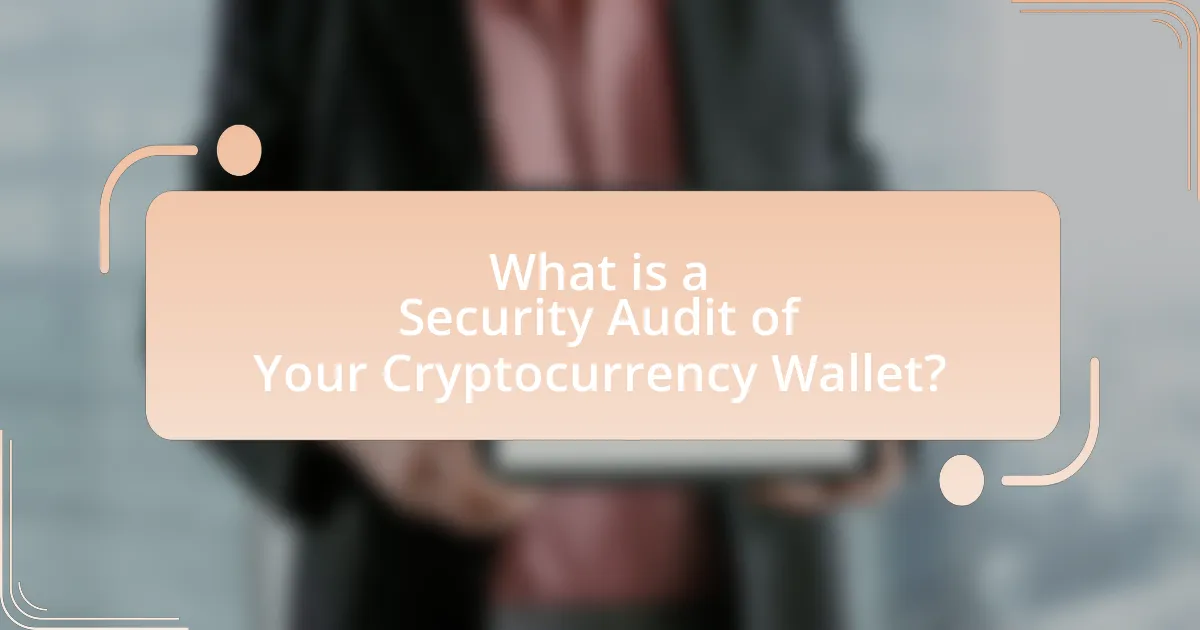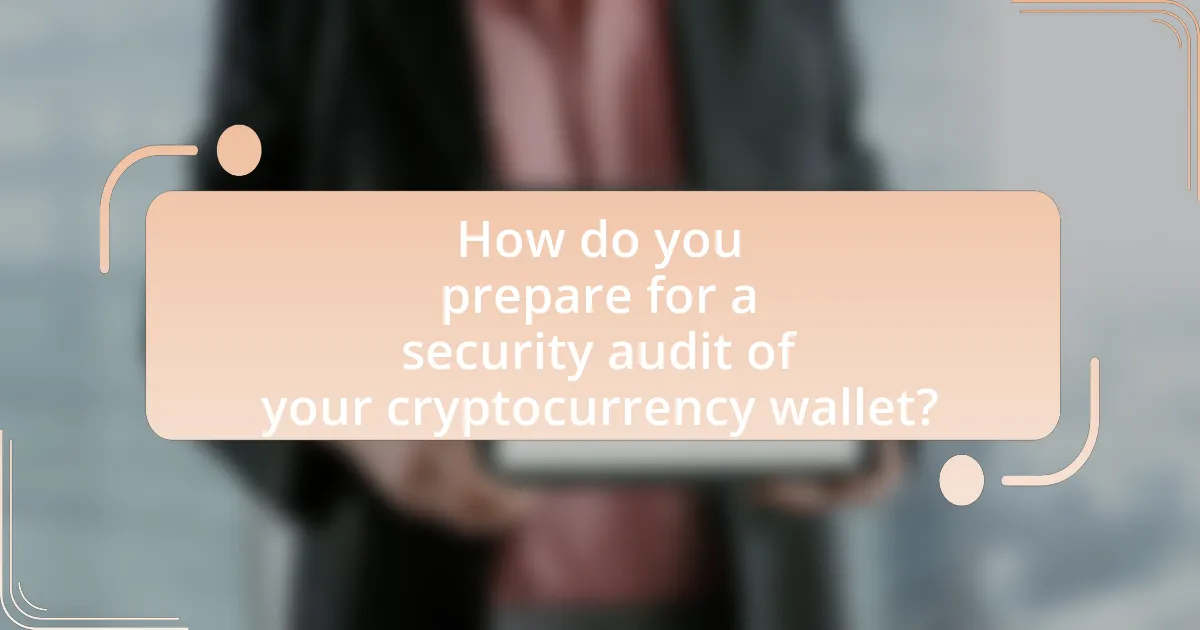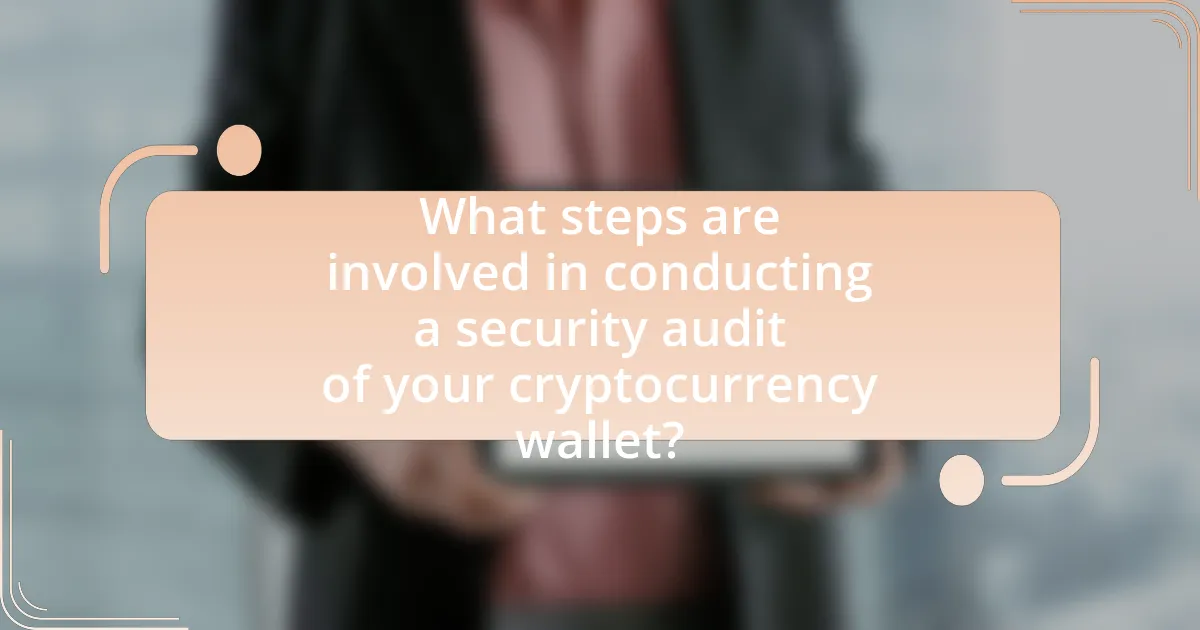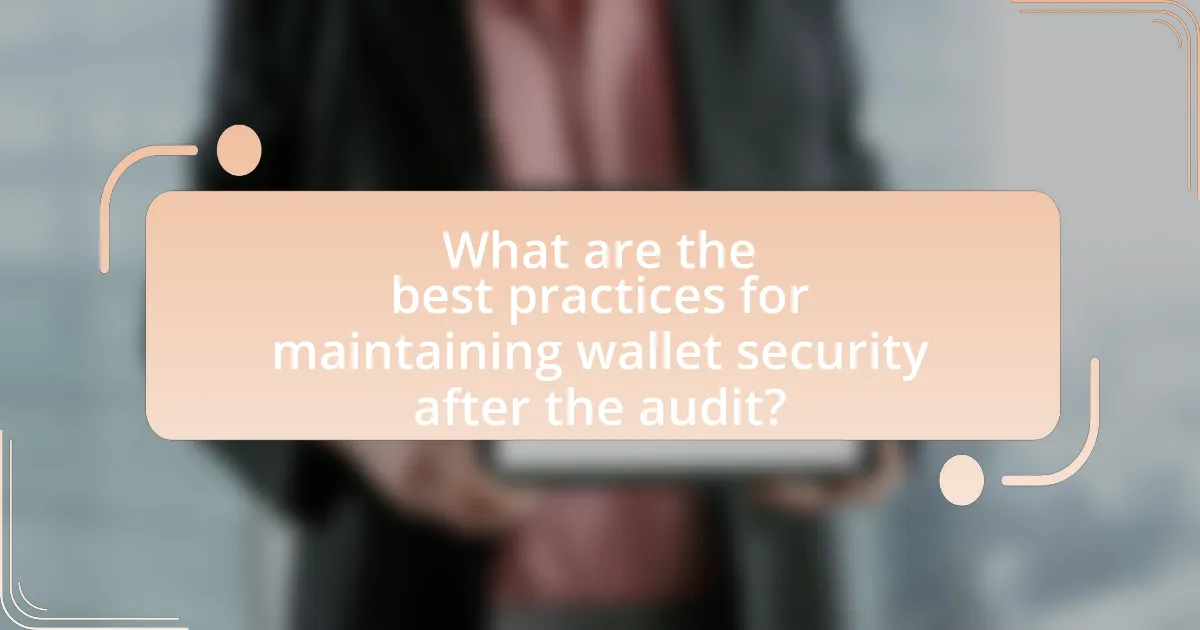A security audit of a cryptocurrency wallet is a systematic evaluation aimed at identifying vulnerabilities and enhancing the protection of digital assets. This article outlines the importance of conducting regular audits to mitigate risks associated with unauthorized access and potential financial losses. Key components of a security audit include assessing access controls, transaction monitoring, and compliance checks, while common vulnerabilities such as weak passwords and outdated software are highlighted. The article also discusses tools and techniques for effective audits, steps for preparation, and best practices for maintaining wallet security post-audit, emphasizing the critical role of user behavior in safeguarding cryptocurrency assets.

What is a Security Audit of Your Cryptocurrency Wallet?
A security audit of your cryptocurrency wallet is a systematic evaluation of the wallet’s security measures to identify vulnerabilities and ensure the protection of digital assets. This process involves analyzing the wallet’s software, hardware, and user practices to detect potential risks such as weak passwords, outdated software, or insecure storage methods. For instance, a study by the Blockchain Security Alliance highlights that 80% of cryptocurrency thefts occur due to poor security practices, underscoring the importance of conducting regular audits to safeguard assets effectively.
Why is conducting a security audit important for cryptocurrency wallets?
Conducting a security audit is crucial for cryptocurrency wallets because it identifies vulnerabilities that could lead to unauthorized access and loss of funds. Security audits systematically evaluate the wallet’s code, configurations, and operational practices to ensure they adhere to best security practices. For instance, a study by the Blockchain Security Alliance found that 70% of cryptocurrency thefts stem from poor security measures, highlighting the necessity of regular audits to mitigate risks. By identifying weaknesses, users can implement necessary improvements, thereby enhancing the overall security posture of their wallets.
What risks are associated with not auditing your cryptocurrency wallet?
Not auditing your cryptocurrency wallet exposes you to significant risks, including potential loss of funds, security vulnerabilities, and undetected fraudulent activities. Without regular audits, users may overlook unauthorized transactions or security breaches, leading to irreversible financial losses. For instance, a study by Chainalysis in 2021 revealed that over $7.7 billion worth of cryptocurrency was stolen through hacks, many of which could have been mitigated by regular wallet audits. Additionally, failing to audit can result in the accumulation of outdated security practices, making wallets more susceptible to attacks.
How can a security audit enhance the safety of your assets?
A security audit enhances the safety of your assets by identifying vulnerabilities and weaknesses in your security protocols. By systematically evaluating your cryptocurrency wallet’s security measures, the audit reveals potential entry points for cyber threats, allowing you to address these issues proactively. For instance, a study by the Cybersecurity & Infrastructure Security Agency (CISA) indicates that regular security assessments can reduce the risk of breaches by up to 70%. This proactive approach not only fortifies your defenses but also ensures compliance with best practices in asset protection, ultimately safeguarding your investments from theft and loss.
What are the key components of a security audit for cryptocurrency wallets?
The key components of a security audit for cryptocurrency wallets include access control, transaction monitoring, vulnerability assessment, and compliance checks. Access control ensures that only authorized users can access the wallet, which is critical for preventing unauthorized transactions. Transaction monitoring involves analyzing transaction patterns to detect any suspicious activities, thereby enhancing security. Vulnerability assessment identifies potential weaknesses in the wallet’s software and infrastructure, allowing for timely remediation. Compliance checks ensure that the wallet adheres to relevant regulations and best practices, which is essential for maintaining trust and security in cryptocurrency transactions.
What tools and techniques are commonly used in security audits?
Commonly used tools and techniques in security audits include vulnerability scanners, penetration testing tools, and compliance checklists. Vulnerability scanners, such as Nessus and Qualys, automate the identification of security weaknesses in systems. Penetration testing tools, like Metasploit and Burp Suite, simulate attacks to evaluate the effectiveness of security measures. Compliance checklists, based on standards like ISO 27001 and NIST, guide auditors in assessing adherence to security policies and regulations. These tools and techniques collectively enhance the thoroughness and accuracy of security audits, ensuring comprehensive evaluations of security postures.
How do you assess the security features of your wallet?
To assess the security features of a wallet, one should evaluate its encryption methods, two-factor authentication, and backup options. Encryption methods protect user data by converting it into a secure format, making it unreadable without the correct key. For instance, wallets that utilize AES-256 encryption are considered highly secure. Two-factor authentication adds an extra layer of security by requiring a second form of verification, such as a text message or authentication app, which significantly reduces the risk of unauthorized access. Additionally, assessing backup options is crucial; wallets that offer secure recovery phrases or seed phrases allow users to restore access in case of device loss. These features collectively contribute to a wallet’s overall security posture.

How do you prepare for a security audit of your cryptocurrency wallet?
To prepare for a security audit of your cryptocurrency wallet, first, ensure that all wallet software is up to date, as updates often include critical security patches. Next, conduct a comprehensive review of your wallet’s access controls, including two-factor authentication and recovery phrases, to verify that they are secure and not shared. Additionally, perform a thorough inventory of your cryptocurrency holdings and transaction history to identify any unauthorized transactions or anomalies. Finally, consider using third-party security tools to scan for vulnerabilities and assess the overall security posture of your wallet. These steps are essential as they help mitigate risks and enhance the security of your cryptocurrency assets.
What preliminary steps should you take before starting the audit?
Before starting the audit of a cryptocurrency wallet, you should gather all relevant documentation and access credentials. This includes obtaining transaction histories, wallet addresses, and any security measures currently in place, such as two-factor authentication. Ensuring that you have a comprehensive understanding of the wallet’s structure and previous security incidents is crucial, as it allows for a more thorough evaluation. Additionally, reviewing the latest security protocols and best practices in cryptocurrency management will provide a solid foundation for the audit process.
How do you gather necessary information about your wallet?
To gather necessary information about your wallet, you should first review the wallet’s documentation and user interface for details on its features and security measures. This includes checking for supported cryptocurrencies, private key management, and backup options. Additionally, you can research online reviews and community feedback to assess the wallet’s reputation and any reported vulnerabilities. For example, a study by the Blockchain Security Alliance highlights that wallets with multi-signature support and two-factor authentication are generally more secure, providing concrete evidence of enhanced protection against unauthorized access.
What documentation is essential for a thorough audit?
Essential documentation for a thorough audit includes transaction records, wallet addresses, security protocols, and access logs. Transaction records provide a detailed history of all cryptocurrency movements, while wallet addresses are crucial for identifying the specific wallets involved. Security protocols outline the measures taken to protect the wallet, and access logs track who accessed the wallet and when. These documents collectively ensure transparency and accountability, which are vital for an effective audit process.
What common vulnerabilities should you look for during the audit?
During a security audit of a cryptocurrency wallet, common vulnerabilities to look for include weak passwords, outdated software, and insecure private key storage. Weak passwords can be easily compromised, leading to unauthorized access; statistics show that 81% of data breaches are linked to weak or stolen passwords. Outdated software may contain known vulnerabilities that attackers can exploit, as evidenced by the fact that 60% of breaches involve unpatched software. Insecure private key storage, such as storing keys in plaintext or on easily accessible devices, increases the risk of theft, with reports indicating that 70% of cryptocurrency thefts are due to poor key management practices.
How can you identify weak passwords and authentication methods?
Weak passwords and authentication methods can be identified by analyzing their complexity, length, and common patterns. Passwords that are less than eight characters, use easily guessable information (like birthdays or common words), or follow predictable patterns (such as “123456” or “password”) are considered weak. Additionally, authentication methods that rely solely on single-factor authentication, such as a password without any additional verification steps, are also vulnerable. Research indicates that 81% of data breaches are linked to weak or stolen passwords, highlighting the importance of robust password policies and multi-factor authentication to enhance security.
What signs indicate potential malware or phishing attacks?
Signs indicating potential malware or phishing attacks include unexpected pop-up messages, unusual system behavior, and unsolicited emails requesting sensitive information. These signs are critical as they often precede unauthorized access or data breaches. For instance, a report from the Anti-Phishing Working Group noted that in 2021, phishing attacks increased by 22% compared to the previous year, highlighting the prevalence of such threats. Additionally, malware may cause slow system performance or frequent crashes, which are indicators of compromised devices. Recognizing these signs can help users take preventive measures to secure their cryptocurrency wallets.

What steps are involved in conducting a security audit of your cryptocurrency wallet?
To conduct a security audit of your cryptocurrency wallet, follow these steps: First, assess the wallet type, determining whether it is a hardware, software, or paper wallet. Next, review the wallet’s security features, such as two-factor authentication and encryption methods. Then, check for software updates and ensure that the wallet is running the latest version to protect against vulnerabilities. After that, analyze transaction history for any unauthorized activities, and verify the wallet’s recovery phrase or private keys are securely stored. Finally, evaluate the overall security practices, including password strength and backup procedures, to ensure comprehensive protection. These steps are essential for identifying potential risks and enhancing the security of your cryptocurrency assets.
How do you evaluate the wallet’s software and hardware security?
To evaluate a wallet’s software and hardware security, one must assess the underlying code for vulnerabilities and the physical components for tamper resistance. Software security can be evaluated by reviewing the wallet’s source code for known vulnerabilities, ensuring it follows best practices for cryptographic algorithms, and checking for regular updates and patches from the developers. Hardware security involves examining the wallet’s design for physical tampering protections, such as secure enclaves or hardware security modules, and verifying that it has undergone third-party security audits, which provide evidence of its resilience against attacks. For instance, wallets like Ledger and Trezor have been independently audited, confirming their robust security measures.
What specific software vulnerabilities should you check for?
You should check for specific software vulnerabilities such as SQL injection, cross-site scripting (XSS), buffer overflow, and insecure deserialization. SQL injection allows attackers to manipulate database queries, potentially exposing sensitive data. Cross-site scripting (XSS) can enable attackers to execute malicious scripts in users’ browsers, compromising user sessions. Buffer overflow vulnerabilities occur when a program writes more data to a buffer than it can hold, leading to arbitrary code execution. Insecure deserialization can allow attackers to execute arbitrary code by manipulating serialized data. These vulnerabilities are critical to identify and mitigate during a security audit of your cryptocurrency wallet to ensure its integrity and security.
How do hardware wallets compare in terms of security?
Hardware wallets provide superior security compared to software wallets and online exchanges. They store private keys offline, significantly reducing the risk of hacking and malware attacks. According to a study by the University of Cambridge, hardware wallets are less vulnerable to phishing attacks and unauthorized access, as they require physical confirmation for transactions. This physical security measure, combined with encryption and secure chip technology, makes hardware wallets one of the safest options for managing cryptocurrency assets.
What processes should you follow to test the wallet’s security?
To test a wallet’s security, you should follow a systematic approach that includes vulnerability assessment, penetration testing, and code review. Vulnerability assessment involves scanning the wallet for known security flaws using tools like OWASP ZAP or Nessus, which can identify weaknesses in the wallet’s architecture. Penetration testing simulates attacks to evaluate the wallet’s defenses, ensuring that it can withstand real-world threats; this can be performed using frameworks like Metasploit. Code review entails examining the wallet’s source code for security best practices and potential vulnerabilities, which is crucial for identifying issues that automated tools may miss. These processes collectively ensure a comprehensive evaluation of the wallet’s security posture.
How do you perform penetration testing on your wallet?
To perform penetration testing on your wallet, you begin by identifying potential vulnerabilities in the wallet’s software and infrastructure. This involves using tools such as Burp Suite or OWASP ZAP to scan for weaknesses in the wallet’s web interface and APIs. Additionally, you should conduct manual testing to exploit identified vulnerabilities, such as SQL injection or cross-site scripting, to assess the wallet’s security posture.
Evidence of the effectiveness of this approach can be found in the OWASP Testing Guide, which outlines specific testing techniques and methodologies that have been validated in real-world scenarios. By following these guidelines, you can systematically evaluate the security of your cryptocurrency wallet.
What role does user behavior play in wallet security testing?
User behavior significantly impacts wallet security testing by influencing the likelihood of security breaches. Human actions, such as weak password choices, failure to enable two-factor authentication, and susceptibility to phishing attacks, can create vulnerabilities in wallet security. Research indicates that 81% of data breaches are linked to weak or stolen passwords, highlighting the critical role user behavior plays in maintaining wallet integrity. Therefore, understanding and addressing user behavior is essential for effective wallet security testing and risk mitigation.

What are the best practices for maintaining wallet security after the audit?
To maintain wallet security after an audit, implement multi-factor authentication (MFA) to add an extra layer of protection against unauthorized access. MFA significantly reduces the risk of breaches, as it requires users to provide two or more verification factors to gain access. Regularly update wallet software to patch vulnerabilities and enhance security features, as outdated software can be exploited by attackers. Additionally, utilize hardware wallets for storing significant amounts of cryptocurrency, as they are less susceptible to online threats compared to software wallets. Conduct periodic security assessments to identify and address potential weaknesses, ensuring that security measures remain effective over time. Finally, educate all users about phishing attacks and safe practices, as human error is often a primary factor in security breaches.
How can you implement the findings from your security audit?
To implement the findings from your security audit, prioritize addressing the identified vulnerabilities by developing a remediation plan that includes specific actions, timelines, and responsible parties. This structured approach ensures that each vulnerability is systematically mitigated, enhancing the overall security posture of your cryptocurrency wallet. For instance, if the audit reveals weak passwords, enforce a policy requiring strong, unique passwords and implement two-factor authentication. According to a study by Verizon, 81% of data breaches are linked to weak or stolen passwords, underscoring the importance of this measure. Regularly review and update security protocols based on audit findings to maintain robust defenses against evolving threats.
What changes should you make to your wallet settings?
To enhance the security of your cryptocurrency wallet, you should enable two-factor authentication (2FA) and regularly update your recovery phrases. Enabling 2FA adds an extra layer of security by requiring a second form of verification, which significantly reduces the risk of unauthorized access. Regularly updating your recovery phrases ensures that you maintain control over your wallet in case of loss or theft, as outdated phrases may be compromised. According to cybersecurity best practices, implementing these changes can mitigate risks associated with wallet vulnerabilities.
How often should you conduct security audits in the future?
You should conduct security audits of your cryptocurrency wallet at least annually. Regular audits help identify vulnerabilities and ensure compliance with evolving security standards. According to the National Institute of Standards and Technology (NIST), annual assessments are essential for maintaining a robust security posture, especially in the rapidly changing landscape of cryptocurrency. Additionally, if there are significant changes in your wallet’s configuration or if new threats emerge, conducting audits more frequently, such as quarterly, is advisable to mitigate risks effectively.
What tips can help you enhance the security of your cryptocurrency wallet?
To enhance the security of your cryptocurrency wallet, implement strong passwords and enable two-factor authentication (2FA). Strong passwords should be complex, combining letters, numbers, and symbols, making them difficult to guess. According to a 2021 study by the Cybersecurity & Infrastructure Security Agency, using 2FA can reduce the risk of unauthorized access by 99.9%. Additionally, regularly updating wallet software and keeping backups in secure locations further protects against potential threats.
How can you stay informed about the latest security threats?
To stay informed about the latest security threats, regularly follow reputable cybersecurity news sources and subscribe to threat intelligence feeds. Cybersecurity news outlets like Krebs on Security and Threatpost provide timely updates on emerging threats, while organizations such as the Cybersecurity and Infrastructure Security Agency (CISA) offer alerts and advisories. Additionally, participating in cybersecurity forums and communities, such as those on Reddit or specialized platforms like Stack Exchange, can provide insights from industry professionals. Engaging with these resources ensures access to accurate and current information regarding security threats.
What resources are available for ongoing wallet security education?
Ongoing wallet security education resources include online courses, webinars, and security blogs. Platforms like Coursera and Udemy offer courses specifically focused on cryptocurrency security, while organizations such as the Blockchain Association provide webinars and workshops. Additionally, reputable blogs like CoinDesk and CryptoSlate regularly publish articles on wallet security best practices and emerging threats. These resources are essential for staying informed about the latest security measures and vulnerabilities in the cryptocurrency space.